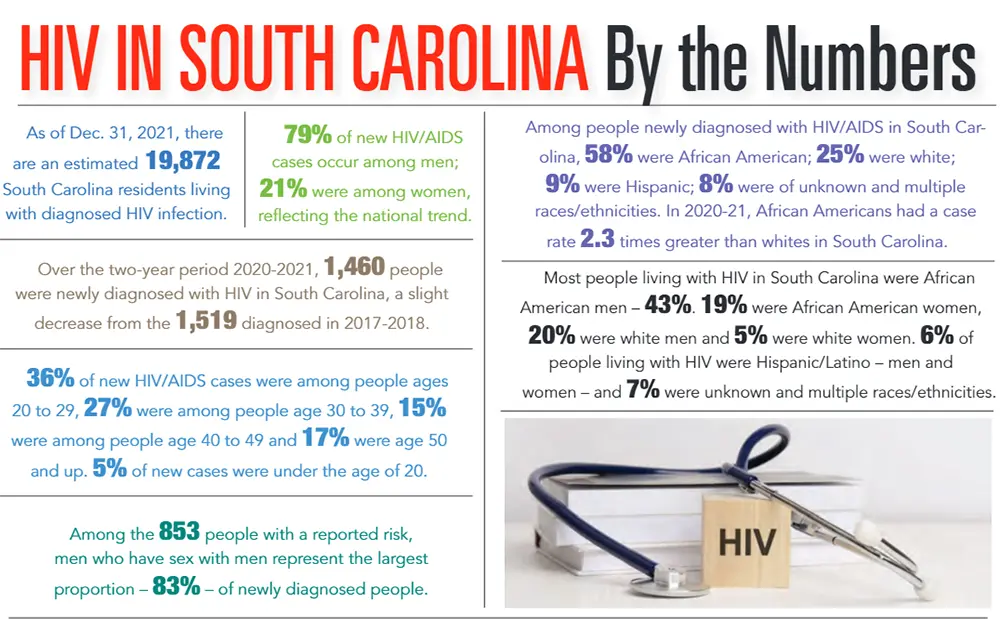Although obstacles remain, there has been a lot of promising news and statistics surrounding HIV/AIDS in the last decade or so. Annual HIV infections in the United States have decreased by more than two-thirds since the height of the epidemic in the mid-1980s, according to hiv.gov. Breakthrough medications are helping patients with HIV/AIDS experience a better quality of live and live longer than ever before.
In South Carolina, newly-diagnosed HIV cases have seen a slight decrease over the past decade, from 1,500 new cases in 2010-11 to 1,460 in 2020-21. While there have been some fluctuations, “it’s been fairly constant,” said Tony Price, prevention program manager with the state Department of Health and Environmental Control’s Division of STD, HIV and Viral Hepatitis. However, Price elaborated that community-based HIV programs have led to increased access to testing and services, meaning a higher number of cases are being identified and reported than in previous decades.
Mirroring the national trend, HIV mortality rates are down in the state as well, with deaths seeing an overall decline in the past two decades-plus since 1997. Prior to the 2000s, in the early stages of the AIDS epidemic, deaths were on the rise.
“We now have an aging population living with HIV/AIDS,” noted Price. “Previously, you didn’t see people living into their 50s and 60s with the disease. The good news is, people are living longer, healthier lives.”
Women in particular have seen a decrease in newly-diagnosed HIV cases within the past 10 years, experiencing a decline of 28%. But the news regarding newly-diagnosed cases isn’t all positive.
Gender and Racial Disparities – Overcoming Barriers to Care
While many of the state’s overall HIV statistics compared to a decade or more ago are encouraging, there are wide racial and gender disparities in prevalence rates that reflect the national numbers.
Cases have remained steady among men and have increased among African Americans. While race and ethnicity are not a risk factor for HIV – men who have unprotected sex with men is the predominant risk factor – the disease does disproportionally affect Black populations. African Americans had a 2.3 times higher case rate of HIV than whites in South Carolina in 2020-21, despite comprising significantly less of the state’s population – 26.3% to 68.9%.
Part of the explanation for the gender gap is that men don’t seek health care as often as women. Additionally, there are barriers to access to care for African American men, especially those living in rural areas.
“Testing is not always equal across the state,” stated Price.
To help address this inequity, among other things, DHEC began offering an HIV Home Testing program.
Another challenge is overcoming the stigma associated with AIDS in the African American community, which can deter individuals from seeking treatment and services. The Latino community has also been difficult to reach with HIV prevention and care.
To combat the problem, DHEC has been working with community health centers and its county-based partners in a collaborative effort to normalize HIV testing, make it a standardized part of health care and reduce the stigma. Moreover, a round of federal funding made available through the national Ending the HIV Epidemic initiative was recently used in South Carolina to initiate five mobile HIV/AIDS testing centers that travel to rural communities as well as to expand HIV testing into retail pharmacies.
To further these goals of improving access to HIV care, Leigh Oden, DHEC’s Ryan White Part B administration manager, said DHEC has disbursed Ryan White HIV/AIDS program funds in support of prevention efforts to ensure that clients can access care quickly. It funded linkage to care coordinators and peer navigators to connect people to care for early access to antiviral meds. As a result of these endeavors, in most cases, clients can be linked to care and provided medication within a week.
The Evolution of HIV/AIDS Medications and Increased Life Expectancy
HIV/AIDS medication and treatments have come a long way since the epidemic arose in the 1980s. In the early ’80s, cocktails of medications used to treat the disease often caused severe side effects, explained Roshan McDaniel, DHEC program manager with the AIDS Drug Assistance Program. For people who contracted AIDS in those formative years, even with medications, life expectancy remained low. AIDS grew to become a leading cause of death among young adults during the 1980s.
Then around the early 2000s, drug manufacturers approved a single tablet regimen with greatly reduced side effects. This advancement in treatment led to people with HIV/AIDS living longer and having an improved quality of life.
Now there is another alternative available, a relatively new form of HIV treatment and prevention introduced in recent years. Long-acting injectables offer the dual benefits of low side effects and no pill fatigue. People receive two injections of antiretroviral drugs at once but only every other month, which significantly reduces the viral load in the body. Additional long-acting injectables are poised to hit the market soon, according to McDaniel.
“The person can lead a very healthy life and can prevent spread to their partner if they take it as prescribed,” said McDaniel.
Price said that this treatment approach aligns with DHEC’s “U=U” motto – undetectable equals untransmittable – because low to no viral load helps prevent the spread of HIV.
“If you can get people rapidly linked to treatment, and they have an undetectable viral load, it has great impact across the board, and, over time, greatly diminishes the spread of HIV,” asserted Price.
*Information courtesy of SC DHEC 2022 HIV/Aids summary, DHEC’s 2022 South Carolina Epidemiologic Profile of HIV, AIDS, and Sexually Transmitted Infections
Additional article sources: https://scdhec.gov/sites/default/files/media/docu ment/2022-EPI-State-Profile.pdf, https://www.hiv.gov/hiv-basics/overview/data and-trends/statistics/, http://www.cdc.gov/hiv/library/reports/hiv-surveillance. html, https://www.cdc.gov/mmwr/preview/mmwrhtml/00001880.htm#:~:text=From%201981%20through%201990.
By Colin McCandless








